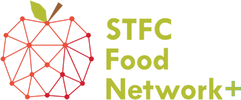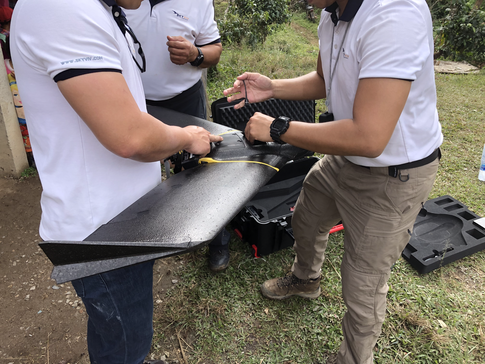 Typical symptoms of a coffee plant infected with coffee rust (Oliver Windram) Typical symptoms of a coffee plant infected with coffee rust (Oliver Windram) Specially-equipped drones could soon help small holder farmers control one of the deadliest killers of coffee plants. Coffee is one of the most traded agricultural commodities and has become a lifeline for many developing regions in the world. This includes the Chiang Mai region in Thailand, where the government is on a mission to become the ‘coffee capital of South-East Asia’, focusing on the premium Arabica varieties. But these ambitions could be jeopardised by a parasitic fungus. Coffee leaf rust is a global disease which attacks the leaves of coffee plants, ultimately decimating the coffee bean harvest. The fungal spores spread easily via wind and rain, meaning that a single outbreak can wipe out plantations over entire regions. Sri Lanka, for instance, was once exclusively planted with coffee until a coffee leaf rust epidemic in 1892 destroyed all of the trees, prompting the farmers to plant tea instead. With fungicides being prohibitively expensive and not an option for organically-certified farms, the only way smallholder farmers can control the parasite is to remove infected plants as soon as possible. Yet even this is currently a challenge – although this STFC-funded project could soon make the process much easier. “It’s very difficult for these farmers to monitor coffee leaf rust, because the plantations are often on the sides of rugged mountains and intercropped with different species: very different from the neat rows we have on UK farms” explains Anthony Brown (Durham University). He first became aware of the problem of coffee leaf rust when he was introduced via the STFC Food Network+ to Oliver Windram, a researcher of remote-sensing technologies for crop plants (Imperial College, London). Oliver’s earlier research in plant pathology had uncovered a real need within agriculture for methods that could quantitatively measure plant disease in the field. This led him to develop remote-sensing technologies for measuring disease on wheat and broccoli, using machine learning to detect and quantify infection. Together, Oliver and Anthony proposed an image-based detection system using drones that could easily fly over the hillsides, allowing infected plants to be identified much more quickly. This draws on Anthony’s expertise in data analytics and unmanned aerial vehicles, and is based on recording spectral data. Their method measures the wavelengths of light reflected off the surface of the plant leaves and records how the intensity of light varies as a function of frequency. The result is a ‘heatmap’ where a large difference in signal intensity indicates the presence of coffee leaf rust. The project began with field visits to coffee plantations in Thailand to test which wavelengths could most accurately discriminate between healthy and infected plants. This in itself proved an experience: “It was the first time I realised that coffee berries are actually red!” Anthony jokes. The team walked among the plants with spectroscopes to compare the signatures of reflected light from uninfected plants and those with varying degrees of coffee leaf rust. Unfortunately, the optimum wavelengths all fell within a range not covered by commercially-available cameras. “When we tried using off-the-shelf cameras, the images were just not sensitive enough to detect coffee leaf rust. But it is important that this solution is affordable for farmers, who are the ultimate end-users” says Anthony. For this reason, they are now engaging with industrial partners to develop a bespoke filter that would enable a commercial camera to read these wavelengths. Anthony and Oliver hope that by January 2020 the prototype will be ready to undertake proof-of-concept flights over plantations in Thailand. Focusing on the end-user and engaging them throughout the planning stages also made the team realise that there was another potential application for this technique. “Farmers are really keen to know exactly what varieties of Arabica coffee they have, since pure products can command better prices. But there are very few records for these areas” Anthony says. He is confident, however, that spectral imaging could distinguish between them, potentially opening up new markets for small holders. “Interacting with end-users to learn what is important for them – rather than just assuming what they need - has been one of the most rewarding aspects of this project” he says. Nevertheless, interest in this work has also had a “snowball” effect in opening up a plethora of new research opportunities for him. “Through my work for the STFC Food Network+, I have now been invited to collaborate on projects using remote sensing to understand global warming impacts on trees across Europe and Africa, besides mangrove forests in South America”. The experience has certainly made him keen to be involved with more interdisciplinary projects that combine different skill sets to create novel solutions, and credits the STFC Food Network+ for encouraging these opportunities as part of its fundamental strategy. “Applying your expertise from one field to another can take you out of your comfort zone, but also be some of the most impactful work that you do” he concludes.
0 Comments
Your comment will be posted after it is approved.
Leave a Reply. |
AuthorJune 2024 - Archives
June 2024
Categories |
- Home
- Webinars and Events
- About the SFN+
- News
- Blog
- Expert Working Groups
- Funding
-
Publications
- Bioeconomy positioning paper
- SFN+ 5th Annual Conference
- OMM Policy Report
- ‘Multi-Stakeholder International One Day Workshop on Organic Agri-Food Value Chains for Net Zero’ Report
- SFN 2050 UK Net Zero Food report
- Sustainable Cold Food Chain Booklet
- Food Sensing Technologies for Safe and Nutritious Food
- Sustainable urban and vertical farming
- Projects
- Join/Contact Us


 RSS Feed
RSS Feed


